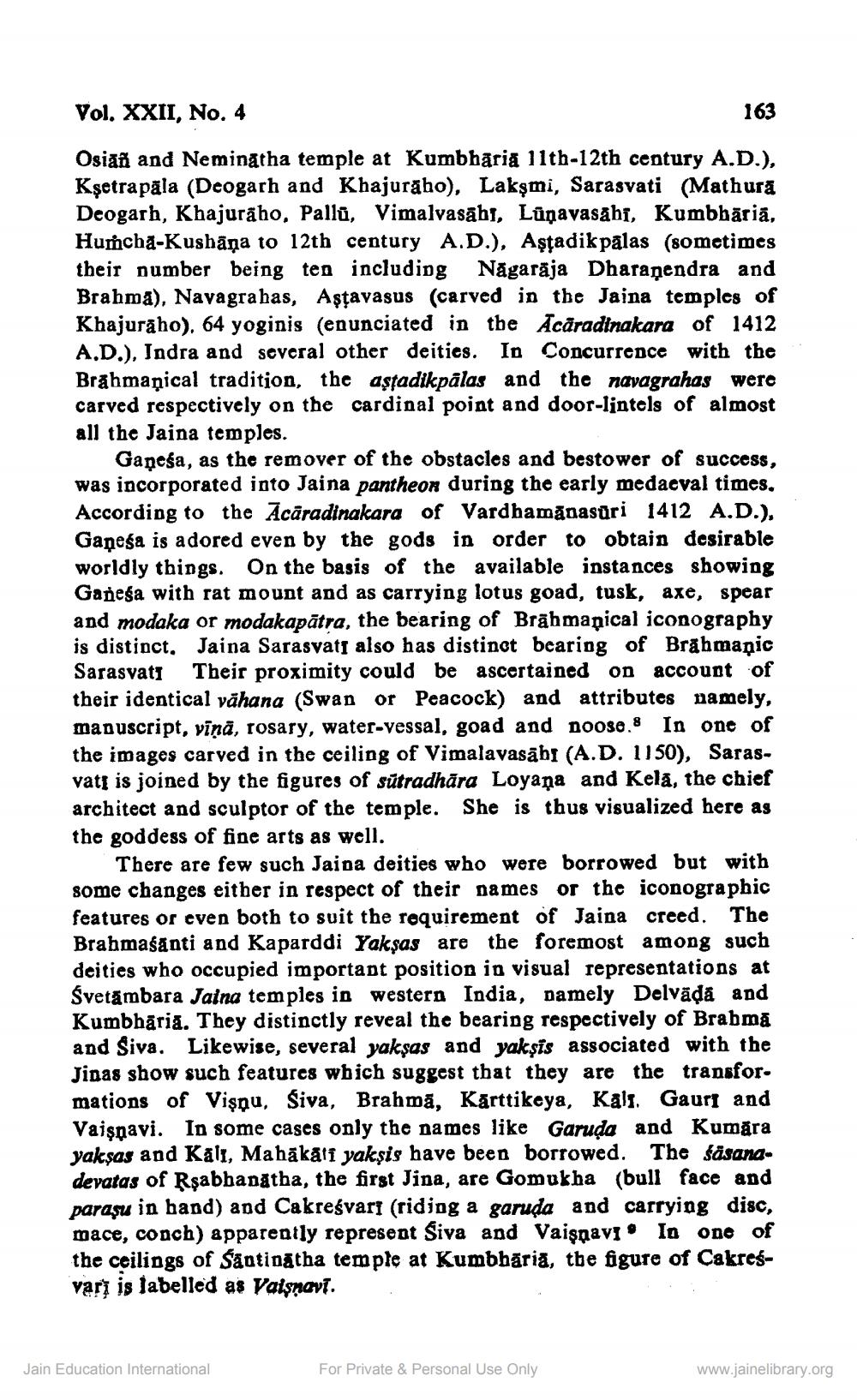________________
Vol. XXII, No. 4
163
Osiāõ and Neminatha temple at Kumbharia 11th-12th century A.D.), Kșetrapāla (Deogarh and Khajuraho), Lakşmi, Sarasvati (Mathura Deogarh, Khajuraho, Pallű, Vimalvasābi, Lūņavasahi, Kumbbāriā, Huncha-Kushāņa to 12th century A.D.), Aşțadik pālas (sometimes their number being ten including Nāgarāja Dharanendra and Brahma), Navagrahas, Aştavasus (carved in the Jaina temples of Khajuraho). 64 yoginis (enunciated in the Acăradinakara of 1412 A.D.), Jadra and several other deities. In Concurrence with the Brāhmaṇical tradition, the aştadikpalas and the navagrahes were carved respectively on the cardinal point and door-lintels of almost all the Jaina temples.
Ganeša, as the remover of the obstacles and bestower of success, was incorporated into Jaina pantheon during the early medacval times, According to the Acaradinakara of Vardhamanasūri 1412 A.D.), Ganeša is adored even by the gods in order to obtain desirable worldly things. On the basis of the available instances showing Ganega with rat mount and as carrying lotus goad, tusk, axe, spear and modaka or modakapātra, the bearing of Brāhmanical iconography is distinct, Jaina Sarasvats also has distinct bearing of Brahmanic Sarasvati Their proximity could be ascertained on account of their identical vähana (Swan or Peacock) and attributes namely, manuscript, vīņā, rosary, water-vessal, goad and noose.8 In one of the images carved in the ceiling of Vimalavasābi (A.D. 1150), Sarasvati is joined by the figures of sūtradhāra Loyana and Kela, the chief architect and sculptor of the temple. She is thus visualized here as the goddess of fine arts as well.
There are few such Jaioa deities who were borrowed but with some changes either in respect of their names or the iconographic features or even both to suit the requirement of Jaina creed. The Brahmaśānti and Kaparddi Yakşas are the foremost among such deities who occupied important position in visual representations at Svetambara Jaina temples in western India, Damely Delvāda and Kumbhāria. They distinctly reveal the bearing respectively of Brabma and Siva. Likewise, several yaksas and yaksis associated with the Jipas show such features which suggest that they are the transformations of Vişnu, Siva, Brahmā, Karttikeya, Kali. Gaur and Vaisnavi. In some cases only the names like Garuda and Kumāra yaksas and Kali, Mahakali yaksis have been borrowed. The fåsanadevatas of Rşabbanatha, the first Jina, are Gomukha (bull face and parasu in band) and Cakreśvari (riding a garuda and carrying disc, mace, conch) appareatly represent Siva and Vaişnavi. In one of the ceilings of Santinātha temple at Kumbharia, the figure of Cakresvary is labelled as Vaisnavi.
Jain Education International
For Private & Personal Use Only
www.jainelibrary.org




